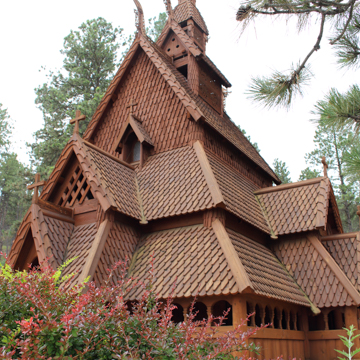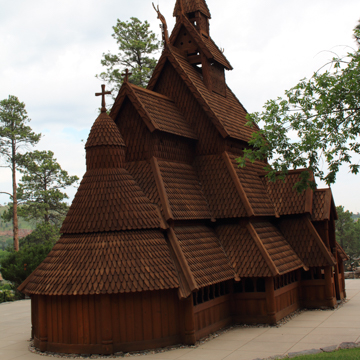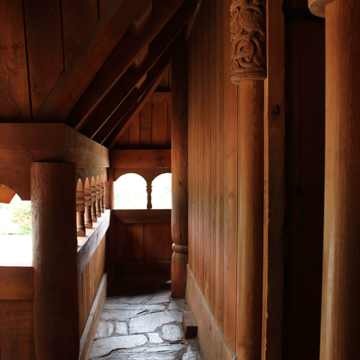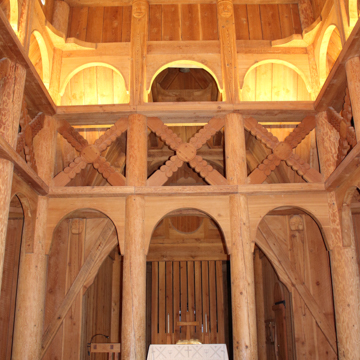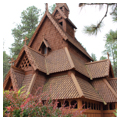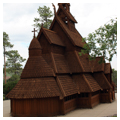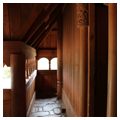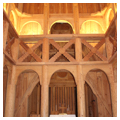The Chapel in the Hills was built in 1968–1969 to house the Lutheran Vespers, the radio ministry of the Evangelical Lutheran Church in America, which began broadcasting in Yankton, South Dakota, in 1947. The Norwegian immigrant population in the United States grew rapidly between 1870 and 1920, with nearly eighty percent of Norwegians settling in the Upper Midwest. In honor of the ancestry of the region’s Norwegian Lutherans, the Chapel is an exact replica of the Borgund Stavkirke outside of Laerdal, Norway, which dates to circa 1150. The Norwegian Department of Antiquities Plans provided plans for the church to William Bentzinger, architect for Spitznagel Partners in Sioux Falls. The church was built by Dilly Construction, a local construction company in Rapid City.
The stave church (or stavkirke) sits on a native Black Hills granite foundation and is constructed primarily of Douglas fir from Oregon, the closest approximation to the original church’s malmfuru, the extremely strong Norwegian ironwood used for the main structural members (or staves). The walls are overlapping vertical planks; the complex roof structure is clad in 16,000 hand-cut wood shakes that provide a surface effect similar to that of pine cones. The church has a cruciform plan with a nave, chancel, and semicircular apse. A covered passageway (ambulatory) surrounds the main body of the church and is partially enclosed. The steeple straddles the gable of the nave segment. Adorning the building are intricate wood carvings, including several crosses, dragons on roof corners, and a rooster atop the building, as well as carved door surrounds and elements within the chapel. Norwegian wood carver Erik Fridstrøm worked with local Rapid City artist Helge Christiansen to execute the carvings.
Siting of the church was important to the ministry, and promoters of the project agreed that it should be similar in some ways to the site of the original church in Norway. Although it was not possible to situate it near a fjord, given its South Dakota location, they selected a site nestled into the edge of a forest area so that the ponderosa pines would serve as a backdrop. Franz Lipp, a nationally known landscape architect from Chicago, developed the overall plan for the property, which included the planting of birch, juniper, mountain ash, Japanese yew, flowering dogwood, and flowering crab apple trees, as well as potentilla, bittersweet, and vibernum shrubs.
More than 1,000 stave churches were constructed in Norway between about 1100 and 1300. Stave churches can be classified into two groups: those that do not have freestanding posts (Type A), and those that do (Type B). Type B churches are further classified as being of the Kaupanger group or the Borgund group. The Kaupanger group gives the impression of a basilica with an arcade row of posts and intermediate posts with stone capitals. Churches of the Borgund group, like the Borgund Stavkirke itself and its South Dakota replica, use cross-braces joining the upper and lower string beams to the posts to form a rigid interconnection that allows for greater technical freedom because the lower posts are omitted. Replicas of other stave churches built in the United States include Boynton Chapel in Door County, Wisconsin, Hopperstad Stave Church in Moorhead, Minnesota, and Scandinavia Heritage Park in Minot, North Dakota.
In addition to the Chapel, an authentic grass-roofed stabbur or storehouse was built in Norway, shipped to Rapid City, and reassembled on the chapel grounds. It now serves as the visitor center. Also on the grounds is an 1876 log cabin, which was constructed by Norwegian immigrant Edward Nielsen and moved to the chapel grounds to house a small museum.
The Lutheran Vespers program relocated to Minneapolis in 1975. Since that time, the chapel has been managed by a nonprofit organization and is open to the public for self-guided tours. Evening services are offered during the summer months.
References
"History of the Chapel in the Hills." Chapel in the Hills. Accessed May 5, 2020. http://www.chapel-in-the-hills.org.
Nelson, Chris, “Chapel in the Hills,” Pennington County, South Dakota. National Register of Historic Places Registration Form, 2012. National Park Service, U.S. Department of the Interior, Washington, D.C.
"Stave Church Architecture and the Stave Churches of Norway." Chapel in the Hills. Accessed May 5, 2020. http://www.chapel-in-the-hills.org.

